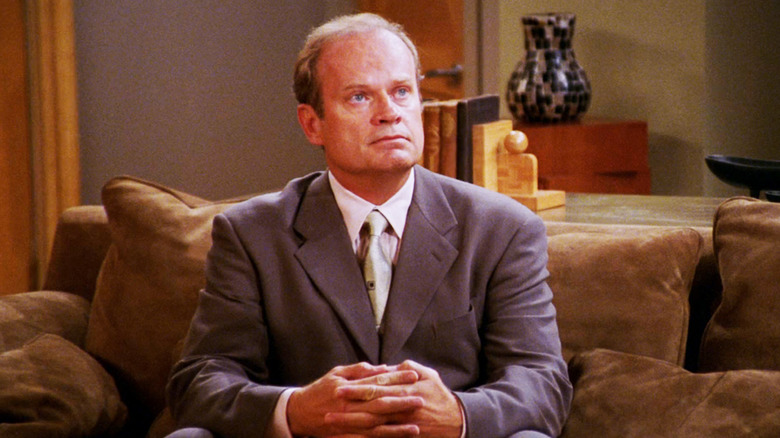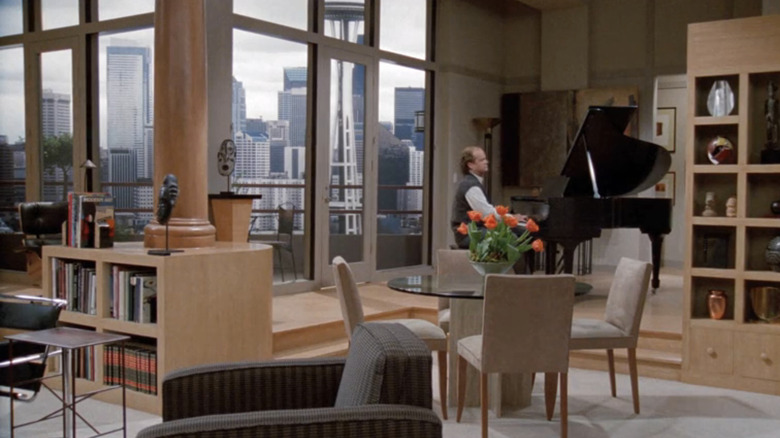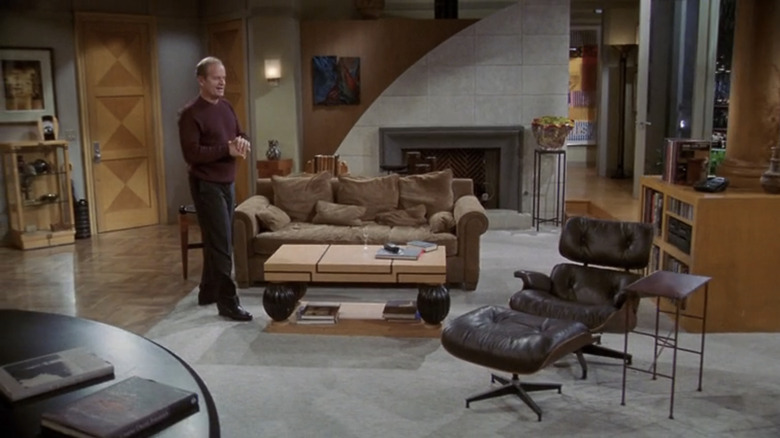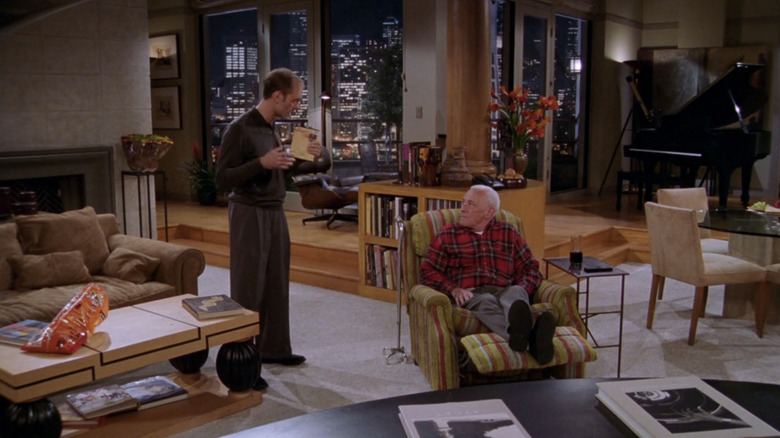One Frasier Set Cost The Show Half A Million Dollars
When "Frasier" returned for a neither remarkable nor disappointing revival series in 2023, several things about the beloved titular doctor's comeback just felt off. The new incarnation of the sitcom was a fairly harmless and light-hearted affair, peppered with flashes of the sitcom magic that characterized the original show. That initial series ran from 1993 to 2004, becoming one of the greatest sitcoms to ever grace our screens. But while the revival saw star Kelsey Grammer firing on all cylinders and gave us a season finale that stacked up nicely against previous Christmas episodes, the supporting cast just wasn't ever going to be able to live up to the original ensemble. All of which made for a revival show that felt kind of like "Frasier," but not quite.
Adding to that uncanny feeling was the fact that "Frasier" 2023 also lacked something of the visual magic of the original. It's perhaps unfair to compare the revival's visual style to a sitcom that benefited from the comforting haze bestowed by the film on which it was shot. It might also be unfair to compare it to a sitcom that emerged from the '90s golden age that also gave us "Seinfeld" and "Friends." But there's much more to the "Frasier" aesthetic than '90s nostalgia.
Dr. Crane's apartment is a good example. The reboot did a decent enough job of setting up its protagonist with swanky living quarters, even bringing back the famous Steinway piano from the original. But like the bar in "Cheers" or Monica's purple apartment in "Friends," Frasier's original Seattle flat in the exclusive Elliot Bay Towers is a truly legendary sitcom set that any '90s kid should easily be able to conjure in their mind's eye. It didn't come cheap, though.
Frasier's apartment was the real deal
In the pilot episode of "Frasier," the titular doctor moves his father, Martin (John Mahoney), into his apartment, thereby setting up the odd-couple dynamic that would characterize the pair's relationship throughout all 11 seasons. Frasier is eager to show off his interior design choices, explaining, "You know, every item here was carefully selected — this lamp by Corbu, the chair by Eames, and this couch is an exact replica of the one Coco Chanel had in her Paris atelier," to which Martin replies with an incredulous, "Nothing matches."
When it came to furnishing the set and ensuring everything was believably high-end, the production team was about as fastidious as Dr. Crane himself. As production designer Roy Christopher explained in a behind-the-scenes clip, "We try to personalize the set as much as possible and really make it as real as possible so you believe it really is where Frasier and his family live."
As Christopher went on to explain, he and his team's dedication to realism made for some particularly difficult set design challenges. For one, they were tasked with creating the "exact replica" Coco Chanel's couch that Frasier mentions in the pilot. That meant researching the original couch and ordering a special recreation to be made with actual suede cloth. Paul Parenteau, head of Parenteau Studios in Chicago, spoke to the Orlando Sentinel back in 1994 and estimated that this couch recreation would have cost "from $15,000 to $20,000."
Elsewhere, set decorator Sharon Viljoen was the one who did all the shopping for Frasier's apartment decorations and furniture. She told the Sentinel that she ”used the normal sources of an interior designer — not prop places — to shop." That dedication to realism clearly paid off, but it made for a hefty overall spend.
Frasier's apartment set wasn't cheap
As noted in the Sentinel article, the table next to the Chanel couch recreation is the "Nick Berman Design Floating Ball side table from the Mimi London showroom in the Pacific Design Center," and was picked up for a cool $2,250. The crew also brought in a "Pastoe curved sideboard" from the "Linea showroom" that ran for $3,200. Sharon Viljoen also noted that the team had a special coffee table built and "rented an Eames chair from Herman Miller in the Pacific Design Center," which evidently ranged from $1,500 to $3,200. As the Sentinel notes, there was also a Ruhlmann club chair worth $8,000 while the Le Corbusier Lamp seen in Frasier's apartment is estimated to have cost around $2,200.
But these were far from the most expensive items in Frasier's apartment. As noted in a 1999 Tampa Bay Times article, the set also featured a $27,000 sculpture by glass artist Dale Chihuly and a $20,000 painting by Julian Schnabel.
According to Mental Floss, all this extravagant interior design added up to around $500,000 (though that figure isn't confirmed in the Sentinel or Tampa Bay Times article). That's not entirely unbelievable considering the production team's attention to detail and commitment to shopping at real interior design locations. Plus, there were other expenses you wouldn't necessarily think about at first. For example, Frasier might be back in Boston for the revival series, but on the original show, he was fully ensconced in his native Seattle, which meant his high-rise home had to look out over the Emerald City skyline — an effect created using a backing sheet which measured 40-feet wide and 20-feet tall and had to be specially made.
Frasier's apartment was worth the high price
Interestingly enough, the cheapest-looking, least refined item in Frasier's apartment might actually have been one of the expensive things on that Paramount soundstage. As Roy Christopher explained in the behind-the-scenes clip, there was nothing on the market that was "awful enough" to be used as Martin's ratty old recliner, which meant Sharon Viljoen was called into action again. As Christopher noted, the set designer "found this old recliner and then went and shopped for a lot of really ugly fabric." He continued. "Finally we found something that everyone agreed really was awful enough and then we had the chair upholstered and then aged and doctored up so it really, really looked disreputable."
While going to such lengths does appear to have taken a hefty chunk out of the show's budget, there's no doubt Frasier's apartment remains one of the greatest sitcom set designs of all time. Speaking to Entertainment Weekly, the production designer for the "Frasier" revival show (which should, in all honesty, have been a one-off special) noted:
"The Seattle apartment was so iconic, and the second I got the call for 'Frasier,' that absolutely was in the forefront of my thought process: How do we make a new apartment yet have those standards?"
Whether you think the revival series overcame that challenge or not, it's clear that Roy Christopher, Sharon Viljoen, and the entire production team's efforts on the original series paid off, to the extent that modern-day set designers are still inspired by their work. Even IndieWire published a whole article featuring multiple contemporary production designers praising Christopher and Viljoen's work. It might have been expensive back then, but Frasier's apartment set was surely worth it.



